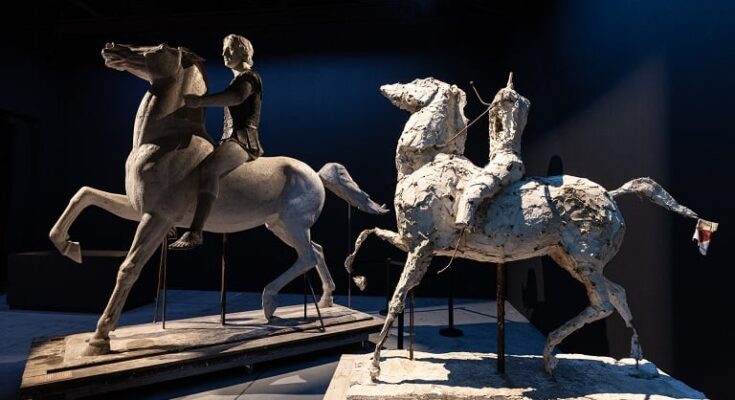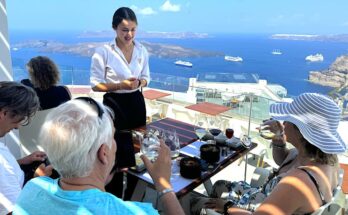A one-of-a-kind exhibition at Fougaro Art Center in Nafplion in partnership with the Benaki Museum of Athens turns the spotlight on late sculptor Yannis Pappas’ sculpture of Alexander the Great on horseback – a masterpiece which took 30 years to complete.
The actual sculpture, cast in bronze, has been located at the center of the Greek capital on the corner of Queen Olga and Queen Amalia avenues since 2019 and is one of a total four sculptures in Athens representing historical figures on horseback.
However, very few people know the fascinating story behind the creation of the masterpiece or appreciate the technical details that make this specific representation of Alexander the Great so special.
Completed in 1972, the 3.5-meter-high sculpture was only unveiled to the public in 1992. This was during a retrospective exhibition of the artist at the National Gallery.
It was acquired by the Ministry of Culture in 1993 and donated to the Municipality of Athens in 2001, but it took authorities another eighteen years—fifteen from the artist’s passing—to place the monument at the spot where it stands to be admired today.
Alexander the Great as a symbol of humanism
The non-commissioned emblematic sculpture was a personal, passionate project of the distinguished modern Greek sculptor Yannis Pappas. It represents Alexander the Great not as a general, a warrior, and conqueror but as an ambassador of Greekness in the furthest corners of the known world. His bronze figure lacks militaristic symbols and symbolisms.
“Worshipped as a god and subject of artistic and intellectual interest until modern times, Alexander has been immortalized by the quest of this great artist as a symbol of humanism,” a Fougaro Art Center spokesperson says in speaking about the sculpture.
Visitors to the Nafplion exhibition, titled “Yannis Pappas, In Quest of Alexander,” will have the opportunity to witness the creative process by following the original initial versions of the work on plaster, the artist’s sketches and studies on the subject, and a rare video from the casting of the final version of the sculpture in bronze in 1972.

The archival material has been sourced from Pappas’ atelier in the Athens neighborhood of Zografou. It is a space which opens regularly to the public, entrusted to Benaki Museum by the artist’s family.
“The exhibition highlights the importance of the concept of obsession in an artist’s work, highlighting that any great work of art is rarely a momentary inspiration, a firework, but usually the result of decades of dedication to a particular subject,” comments Benaki Museum’s Theo Bargiotas, director of Pappas’ atelier and one of the show’s curators.
Alexander the Great, a popular art theme through the centuries
A graduate of the School of Fine Arts of Paris, awarded the gold medal at the 1939 International Exhibition of Paris, the young Yannis Pappas began working on his sculpture of Alexander the Great in 1941 upon his return from the war front to Nazi-occupied Athens.

Credit: Benaki Museum Archive
Although an artist and intellectual, Pappas lived through years of military life much like the great Greek King of Macedon, also a warrior, did 2,300 years earlier.
After World War II, he joined the Royal Navy and served at the Alexandria Naval Command as a seaman. He remained in the city until 1952 before returning to Athens, where, in 1953, he was elected professor of sculpture at the Athens School of Fine Arts. He later served as elected director of the school between 1959 to 1969.
“For three decades, Yannis Pappas systematically and relentlessly researched every detail of the work, examining ancient sculptures and mosaics with representations of Alexander the Great, conducting in-depth anatomical studies of horses from nature as well as making numerous sketches of equestrian statues from the Renaissance and countless other trials in the attempt to find the ideal solution,” according to a Fougaro Art Center spokesperson.

The great Greek sculptor’s thorough research on his masterpiece
Marks from the sculptor’s tools, pencil marks, and nails on the plaster, indicating enlargements and reductions, tell the story of the sculpture’s creation. The sculptor’s own fingerprints, left behind when shaping the sculpture, can also be seen.
“The measurements for proportions, the notes on drawings, the quick sketches made in equestrian clubs and museums, the researched anatomical analysis and the photographs taken as mental notes testify the systematicity and thoroughness in the study of the subject,” points out exhibition curator Antonis J. Kontroyiannis.
The material also demonstrates the breadth of education of Yannis Pappas, “who seems to have assimilated lessons and achievements of artists [that] tackled the subject from antiquity to his own day,” Kontroyiannis argues.

“It also reveals the holistic education, language skills, humor, and ultimately the persistence and dedication of the artist who pursues his vision,” he said.
In the same year—in 1972—that his vision of Alexander’s sculpture materialized in its final form, Pappas became the first Greek artist to be elected as corresponding member to the French Academy.

In the years that followed, he represented Greece in the Venice Biennale with sculptures and paintings, and in 1980, he was elected to the Academy of Athens. He created numerous works for public spaces in Athens and other Greek cities until 1991 and passed away in 2005.
The free admission show, “Yannis Pappas, In Quest of Alexander,” will run until October 2024, Thursday to Sunday 6 – 10 pm, enhanced with educational programs and workshops, talks, and a printed catalogue.



